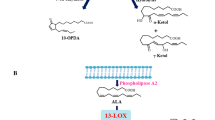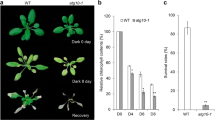Abstract
Peroxiredoxins (Prxs), which are classified into three isotypes in plants, play important roles in protection systems as peroxidases or molecular chaperones. The three Prx isotypes of Chinese cabbage, namely C1C-Prx, C2C-Prx, and C-PrxII, have recently been identified and characterized. The present study compares their molecular properties and biochemical functions to gain insights into their concerted roles in plants. The three Prx isotype genes were differentially expressed in tissue- and developmental stage-specific manners. The transcript level of the C1C-Prx gene was abundant at the seed stage, but rapidly decreased after imbibitions. In contrast, the C2C-Prx transcript was not detected in the seeds, but its expression level increased at germination and was maintained thereafter. The C-PrxII transcript level was mild at the seed stage, rapidly increased for 10 days after imbibitions, and gradually disappeared thereafter. In the localization analysis using GFP-fusion proteins, the three isotypes showed different cellular distributions. C1C-Prx was localized in the cytosol and nucleus, whereas C2C-Prx and C-Prx were found mainly in the chloroplast and cytosol, respectively. In vitro thiol-dependent antioxidant assays revealed that the relative peroxidase activities of the isotypes were CPrxII > C2C-Prx > C1C-Prx. C1C-Prx and C2C-Prx, but not C-PrxII, prevented aggregation of malate dehydrogenase as a molecular chaperone. Taken together, these results suggest that the three isotypes of Prx play specific roles in the cells in timely and spatially different manners, but they also cooperate with each other to protect the plant.
Similar content being viewed by others
References
Alvarez, M.E., Pennell, R.I., Meijer, P.J., Ishikawa, A., Dixon, R.A., and Lamb, C. (1998). Reactive oxygen intermediates mediate a systemic signal network in the establishment of plant immunity. Cell 92, 773–784.
An, B.C., Lee, S.S., Lee, E.M., Lee, J.T., Wi, S.G., Jung, H.S., Park, W., and Chung, B.Y. (2010). A new antioxidant with dual functions as a peroxidase and chaperone in Pseudomonas aeruginosa. Mol. Cells 29, 145–151.
An, B.C., Lee, S.S., Lee, J.T., Hong, S.H., Wi, S.G., and Chung, B.Y. (2011). Engineering of 2-Cys peroxiredoxin for enhanced stress-tolerance. Mol. Cells 32, 257–264.
Baier, M., and Dietz, K.J. (1997). The plant 2-Cys peroxiredoxin BAS1 is a nuclear-encoded chloroplast protein: its expressional regulation, phylogenetic origin, and implications for its specific physiological function in plants. Plant J. 12, 179–190.
Baier, M., and Dietz, K.J. (1999). Protective function of chloroplast 2-cysteine peroxiredoxin in photosynthesis. Evidence from transgenic Arabidopsis. Plant Physiol. 119, 1407–1414.
Brehelin, C., Meyer, E.H., de Souris, J.P., Bonnard, G., and Meyer, Y. (2003). Resemblance and dissemblance of Arabidopsis type II peroxiredoxins: similar sequences for divergent gene expression, protein localization, and activity. Plant Physiol. 132, 2045–2057.
Cakmak, I., Strbac, D., and Marchsner, H. (1993). Activities of hydrogen peroxide-scavenging enzymes in germinating wheat seeds. J. Exp. Bot. 44, 127–132.
Chae, H.Z., Chung, S.J., and Rhee, S.G. (1994). Thioredoxin-dependent peroxide reductase from yeast. J. Biol. Chem. 269, 27670–27678.
Cheong, N.E., Choi, Y.O., Lee, K.O., Kim, W.Y., Jung, B.G., Chi, Y.H., Jeong, J.S., Kim, K., Cho, M.J., and Lee, S.Y. (1999). Molecular cloning, expression, and functional characterization of a 2Cys-peroxiredoxin in Chinese cabbage. Plant Mol. Biol. 40, 825–834.
Choi, Y.O., Cheong, N.E., Lee, K.O., Jung, B.G., Hong, C.H., Jeong, J.H., Chi, Y.H., Kim, K., Cho, M.J., and Lee, S.Y (1999). Cloning and expression of a new isotype of the peroxiredoxin gene of Chinese cabbage and its comparison to 2Cys-peroxiredoxin isolated from the same plant. Biochem. Biophys. Res. Commun. 258, 768–771.
Fisher, A.B., Dodia, C., Manevich, Y., Chen, J.W., and Feinstein, S.I. (1999). Phospholipid hydroperoxides are substrates for nonselenium glutathione peroxidase. J. Biol. Chem. 274, 21326–21334.
Halliwell, B., and Gutteridge, J.M. (1990). Role of free radicals and catalytic metal ions in human disease: an overview. Methods Enzymol. 186, 1–85.
Haslekas, C., Viken, M.K., Grini, P.E., Nygaard, V., Nordgard, S.H., Meza, T.J., and Aalen, R.B. (2003). Seed 1-cysteine peroxiredoxin antioxidants are not involved in dormancy, but contribute to inhibition of germination during stress. Plant Physiol. 133, 1148–1157.
Hofmann, B., Hecht, H.-J., and Flohé, L. (2002). Peroxiredoxins. Biol. Chem. 383, 347–364.
Ichimiya, S., Davis, J.G., O’Rourke, D.M., Katsumata, M., and Greene, M.I. (1997). Murine thioredoxin peroxidase delays neuronal apoptosis and is expressed in areas of the brain most susceptible to hypoxic and ischemic injury. DNA Cell Biol. 16, 311–321.
Jin, D.Y., Chae, H.Z., Rhee, S.G., and Jeang, K.T. (1997). Regulatory role for a novel human thioredoxin peroxidase in NF-kappaB activation. J. Biol. Chem. 272, 30952–30961.
Jin, J.B., Kim, Y.A., Kim, S.J., Lee, S.H., Kim, D.H., Cheong, G.W., and Hwang, I. (2001). A new dynamin-like protein, ADL6, is involved in trafficking from the trans-Golgi network to the central vacuole in Arabidopsis. Plant Cell 13, 1511–1526.
Kang, C.H., Jung, W.Y., Kang, Y.H., Kim, J.Y., Kim, D.G., Jeong, J.C., Baek, D.W., Jin, J.B., Lee, J.Y., Kim, M.O., et al. (2006). AtBAG6, a novel calmodulin-binding protein, induces programmed cell death in yeast and plants. Cell Death Differ. 13, 84–95
Kim, S.Y., Jang, H.H., Lee, J.R., Sung, N.R., Lee, H.B., Lee, D.H., Park, D.J., Kang, C.H., Chung, W.S., Lim, C.O., et al. (2009). Oligomerization and chaperone activity of a plant 2-Cys peroxiredoxin in response to oxidative stress. Plant Sci. 177, 227–232.
Kim, S.Y., Paeng, S.K., Nawkar, G.M., Maibam, P., Lee, E.S., Kim, K-S., Lee, D.H., Park, D.-J., Kang, S.B., Kim, M.R., et al. (2011). The 1-Cys peroxiredoxin, a regulator of seed dormancy, functions as a molecular chaperone under oxidative stress conditions. Plant Sci. 181, 119–124.
Knoops, B., Clippe, A., Bogard, C., Arsalane, K., Wattiez, R., Hermans, C., Duconseille, E., Falmagne, P., and Bernard, A. (1999). Cloning and characterization of AOEB166, a novel mammalian antioxidant enzyme of the peroxiredoxin family. J. Biol. Chem. 274, 30451–30458.
Lee, K.O., Jang, H.H., Jung, B.G., Chi, Y.H., Lee, J.Y., Choi, Y.O., Lee, J.R., Lim, C.O., Cho, M.J., and Lee, S.Y. (2000). Rice 1Cys-peroxiredoxin over-expressed in transgenic tobacco does not maintain dormancy but enhances antioxidant activity. FEBS Lett. 486, 103–106.
Lyu, M.S., Rhee, S.G., Chae, H.Z., Lee, T.H., Adamson, M.C., Kang, S.W., Jin, D.Y., Jeang, K.T., and Kozak, C.A. (1999). Genetic mapping of six mouse peroxiredoxin genes and fourteen peroxire-doxin related sequences. Mamm. Genome 10, 1017–1019.
Moon, J.C., Jang, H.H., Chae, H.B., Lee, J.R., Lee, S.Y., Jung, Y.J., Shin, M.R., Lim, H.S., Chung, W.S., Yun, D.J., et al. (2006). The C-type Arabidopsis thioredoxin 24 reductase ANTR-C acts as an electron donor to 2-Cys peroxiredoxins in chloroplasts. Biochem. Biophys. Res. Commun. 348, 478–484
Park, S.G., Cha, M.K., Jeong, W., and Kim, I.H. (2000). Distinct physiological functions of thiol peroxidase isoenzymes in Saccharomyces cerevisiae. J. Biol. Chem. 275, 5723–5732.
Peshenko, I.V., and Shichi, H. (2001). Oxidation of active center cysteine of bovine 1-Cys peroxiredoxin to the cysteine sulfenic acid form by peroxide and peroxynitrite. Free Radic. Biol. Med. 31, 292–303.
Pulido, P., Dominguez, F., and Cejudo, F.J. (2009a). A hydrogen peroxide detoxification system in the nucleus of wheat seed cells: protection or signaling role?. Plant Signal. Behav. 4, 23–25.
Pulido, P., Cazalis, R., and Cejudo, F.J. (2009b). An antioxidant redox system in the nucleus of wheat seed cells suffering oxidative stress. Plant J. 57, 132–145.
Ross, S.J., Findlay, V.J., Malakasi, P., and Morgan, B.A. (2000). Thioredoxin peroxidase is required for the transcriptional response to oxidative stress in budding yeast. Mol. Biol. Cell 11, 2631–2642.
Sarafian, T.A., Verity, M.A., Vinters, H.V., Shih, C.C., Shi, L., Ji, X.D., Dong, L., and Shau, H. (1999). Differential expression of peroxiredoxin subtypes in human brain cell types. J. Neurosci. Res. 56, 206–212.
Seo, M.S., Kang, S.W., Kim, K., Baines, I.C., Lee, T.H., and Rhee, S.G. (2000). Identification of a new type of mammalian peroxiredoxin that forms an intramolecular disulfide as a reaction intermediate. J. Biol. Chem. 275, 20346–20354.
Scandalios, J.G. (1987). The antioxidant enzyme genes Cat and Sod of maize: regulation, functional significance, and molecular biology. Isozymes Curr. Top Biol. Med. Res. 14, 19–44.
Wood, Z.A., Schroder, E., Robin Harris, J., and Poole, L.B. (2003). Structure, mechanism and regulation of peroxiredoxins. Trends Biochem. Sci. 28, 32–40.
Author information
Authors and Affiliations
Corresponding authors
Additional information
These authors contributed equally to this work.
About this article
Cite this article
Kim, S.Y., Jung, Y.J., Shin, M.R. et al. Molecular and functional properties of three different peroxiredoxin isotypes in Chinese cabbage. Mol Cells 33, 27–33 (2012). https://doi.org/10.1007/s10059-012-2166-8
Received:
Revised:
Accepted:
Published:
Issue Date:
DOI: https://doi.org/10.1007/s10059-012-2166-8




